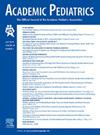在儿科初级保健网络中实施心源性猝死风险筛查。
IF 2.8
3区 医学
Q1 PEDIATRICS
引用次数: 0
摘要
背景:2021年,美国儿科学会(AAP)建议进行普遍的、基于病史的心源性猝死风险筛查,这代表了从基于病史和检查的运动前筛查的扩展。我们在一个大型儿科初级保健网络中研究了普遍心脏风险筛查的实施,以更好地了解最佳工作流程设计、筛查阳性率以及扩大筛查可能产生的潜在系统效应。方法:我们将AAP指南改编为一个三问题筛选器,该筛选器作为患者门户调查问卷实施到电子健康记录中,并具有备份的基于纸张的工作流程。不间断警报提供临床决策支持。测量筛查阳性率和随访率。使用多变量模型比较不同患者的筛查率。结果:在2024年3月1日至2025年2月28日期间,72037名符合条件的患者中,41433名(58%)接受了筛查。其中,3463例(8.4%)具有临床可操作的阳性筛查。31%的病例要求进行随访评估。一个多变量模型表明,不活跃的患者门户状态、青少年患者年龄、“未知”患者种族和公共保险与较低的筛查率有关。结论:在儿科初级保健网络中实施基于病史的普遍心源性猝死风险筛查,经临床医生审查,阳性率为8.4%,这意味着心脏病学转诊的潜在负担很大。超过一半的符合条件的患者进行了筛查,并在少数阳性病例中进行了随访评估,这表明在采用/依从性方面存在差距。这种做法与某些弱势群体的低筛查率有关。本文章由计算机程序翻译,如有差异,请以英文原文为准。
Implementing Sudden Cardiac Death Risk Screening Within a Pediatric Primary Care Network
Objective
In 2021, the American Academy of Pediatrics (AAP) recommended universal, history-based sudden cardiac death risk screening, representing an expansion from history- and exam-based screening for sports preparticipation. We studied the implementation of universal cardiac risk screening within a large pediatric primary care network to better understand optimal workflow design, screening positivity rate, and potential system-based effects that may arise from expanded screening.
Methods
We adapted the AAP guidelines to a 3-question screener implemented into the electronic health record as a patient portal questionnaire with a back-up paper-based workflow. A noninterruptive alert provided clinical decision support. Screening positivity rates and rates of follow-up actions were measured. Screening rates were compared across patient demographics using a multivariable model.
Results
Between March 1, 2024, and February 28, 2025, of 72,037 eligible patients, 41,433 (58%) were screened. Of these, 3463 (8.4%) had a clinically actionable positive screen. Follow-up evaluation was ordered in 31% of cases. A multivariable model demonstrated that inactive patient portal status, teenage patient age, patient race of “Unknown,” and public insurance were associated with lower screening rates.
Conclusions
Implementing universal history-based sudden cardiac death risk screening in a pediatric primary care network exhibited an 8.4% positivity rate after clinician review, representing a large potential burden of cardiology referrals. Over half of eligible patients were screened, and follow-up evaluation was ordered in a minority of positive cases, signaling a gap in adoption/adherence. This implementation was associated with lower screening rates in certain disadvantaged populations.
求助全文
通过发布文献求助,成功后即可免费获取论文全文。
去求助
来源期刊

Academic Pediatrics
PEDIATRICS-
CiteScore
4.60
自引率
12.90%
发文量
300
审稿时长
60 days
期刊介绍:
Academic Pediatrics, the official journal of the Academic Pediatric Association, is a peer-reviewed publication whose purpose is to strengthen the research and educational base of academic general pediatrics. The journal provides leadership in pediatric education, research, patient care and advocacy. Content areas include pediatric education, emergency medicine, injury, abuse, behavioral pediatrics, holistic medicine, child health services and health policy,and the environment. The journal provides an active forum for the presentation of pediatric educational research in diverse settings, involving medical students, residents, fellows, and practicing professionals. The journal also emphasizes important research relating to the quality of child health care, health care policy, and the organization of child health services. It also includes systematic reviews of primary care interventions and important methodologic papers to aid research in child health and education.
 求助内容:
求助内容: 应助结果提醒方式:
应助结果提醒方式:


